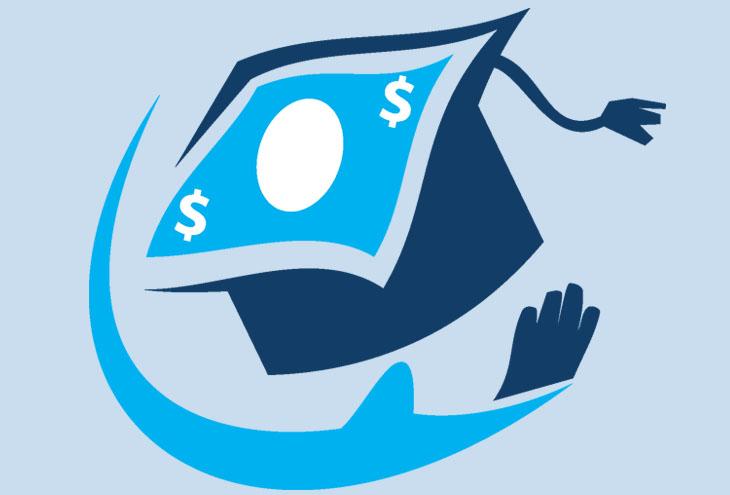How to do it your way
If you’re deciding whether to go to college — or where — you’ve probably noticed some gloom and doom in the media about student loan debt. While it’s true this is a subject to approach seriously, it’s also important to know that student loans aren’t the only game in town when it comes to paying for your higher education.
It’s a reality that the price tag for most colleges and universities is too high for the majority of students and families to pay on their own. That said, the return on an investment in higher education remains significant. According to the Economic Policy Institute, college graduates generally earn salaries that are 50 percent (or more) higher than those of people without post–high school degrees.
Set Up for Success
So when do you begin thinking about how to finance college? Experts agree it should be part of the conversation from the beginning. There’s no substitute for planning ahead — the more prepared you are to address the sticker price, the better positioned you are for success. And when you consider the costs, use a wide lens: You’ll have to pay for more than tuition. Other costs include course-required textbooks, transportation, any devices or software you’ll need, plus room and board if you’re looking at an on-campus experience.
Consider Your Options
Do you want to go to a private college or public university? Big or small school? Close to home or far away? All these factors have financial implications. One option that can offer time to (1) save money and (2) select a major and (3) a four-year school: Go to community college first, then transfer after earning a two-year degree. If you choose this route, it’s important to keep in touch with an academic counselor to ensure you don’t lose any valuable credits when you transfer. In some states, community and four-year colleges are now working together to provide more seamless pathways for students who transfer with an associate degree. Also, transferring to a new school could open up scholarship opportunities.
Wherever you decide to begin your college career, you also have options for charting your course. Sometimes students decide to fast-track their education and graduate in three years to condense college costs, rack up less potential debt, and jump into the job market sooner. While this approach requires proper planning, it can be the right fit for an organized, disciplined student. On the other end of the spectrum, it’s always an option to take — and pay for — fewer credit hours at a time to free up your schedule, work outside school, and/or handle any family responsibilities.
No Matter What, File Your FASFA
To get a realistic view of what financial aid may be possible for you, a critical first step is filing your FASFA (Free Application for Federal Student Aid). The FASFA takes into account your basic financial information to determine how much you’ll be able to contribute to your college education, and how much you’ll need to source elsewhere — for example, scholarships, grants, work-study program, work outside school, and student loans (if you decide to borrow).
“It’s important to file as soon as you can,” says Mark Kantrowitz, publisher and vice president of research at Savingforcollege.com. Kantrowitz emphasizes that the FASFA start date is now October 1 of your senior year in high school (instead of January 1), “which means that most families will have already filed their federal income tax returns.” In addition, he explains, “more families can now use the IRS Data Retrieval Tool to transfer income and tax information from their federal tax returns into the FASFA.” It’s also a good idea to read up on the FASFA in advance and consult resources such as Edvisors’ FASFA Guide and the U.S. Department of Education’s FASFA on the Web Worksheet.
Do Your Homework
In addition to college money you can generate through financial aid and work, there are other ways to raise college money and cut costs:
- Research scholarships and grants. They’re offered every year from hundreds of sources, and you can learn about college scholarships and grants through search engines such as Fastweb, Scholarships.com, and Scholarship Monkey. You can also do it the old-fashioned way: “I suggest compiling your own list of scholarships that could be relevant to your situation — for example, through the Bureau of Indian Affairs,” advises Kantrowitz. “Also, tribes often have scholarship opportunities that may not be widely publicized.”
- Look into testing out. If you’re a strong student, one way to reduce your credit hours and higher education tab is by testing out of classes with Advanced Placement (AP) test scores. It’s ultimately the school’s decision, but you may earn credit for what you've already learned, or get the go-ahead to skip the equivalent college course. Another possibility is accumulating course credits by participating in the College Level Examination Program (CLEP). According to CollegeBoard.org, CLEP exams cover intro-level college course material in 33 subjects, and a passing score on just one CLEP test can save you more than 100 hours of class time and hundreds of tuition dollars.
- If you decide to borrow, do so carefully. Experts agree that you should go after the free money first, earn what you can, and then resort to loans only if that’s the one thing standing between you and college. Kantrowitz advises as a general rule that “every dollar you borrow will end up costing you two dollars by the time you pay it back. So borrow only what’s necessary.” And if you do borrow, read up on smart ways to repay as well as student loan forgiveness plans linked to long-term public service after graduation.
P.S. Don’t Give Up!
Financing any major decision — a car, a home, an education — can seem daunting at the outset. As you become informed, connect with advisors, and explore your options, you’ll be able to put together a doable plan. So think ahead, get prepared, and find the path that will work for you.
 As part of its efforts to assist students as they move forward in their educational journeys, the American Indian Science and Engineering Society (AISES) provides a wide range of scholarship opportunities. These scholarships enable recipients to acquire essential skills and training so they can meet the unique STEM needs of their communities. Brianna Hall, program and development manager at AISES, works closely with scholarship applicants, reviewers, and funders. Here she answers a few of the most common questions related to AISES scholarships. For more information, contact Hall at bhall@aises.org or 720-758-9678.
As part of its efforts to assist students as they move forward in their educational journeys, the American Indian Science and Engineering Society (AISES) provides a wide range of scholarship opportunities. These scholarships enable recipients to acquire essential skills and training so they can meet the unique STEM needs of their communities. Brianna Hall, program and development manager at AISES, works closely with scholarship applicants, reviewers, and funders. Here she answers a few of the most common questions related to AISES scholarships. For more information, contact Hall at bhall@aises.org or 720-758-9678.
Who is eligible to apply for an AISES scholarship?
Each AISES scholarship has its own eligibility requirements regarding GPA, major, and academic status. Please see the individual scholarship pages for eligibility requirements. At a minimum, however, all scholarships require that applicants be a current AISES member at the time of application. In addition, scholarship applicants must be an enrolled member or a descendant of an enrolled member of a state- or federally recognized American Indian tribe or Alaska Native village; Native Hawaiian or a descendant of a Native Hawaiian; Pacific Islander or a descendant of a Pacific Islander; or an Indigenous person of Canada. Enrollment documents and/or a copy of a birth certificate showing descent from an enrolled citizen, Native Hawaiian, Pacific Islander, or Indigenous group of Canada are acceptable as proof. Applicants may, instead, provide a copy of their Certificate of Degree of Indian Blood or Certificate of Degree of Alaska Native Blood (CDIB) card. Please note, AISES may not always have scholarships available for noncitizens of the United States.
When do AISES scholarships open/close?
The scholarship application period is Dec. 15, 2018, through March 31, 2019. Applications are reviewed on a rolling basis from April 16 to June 28, 2019.
When will students be notified about scholarship awards?
Semifinalist scholarship award notifications will begin May 20 and as late as July 19, 2019, depending on when the applications were reviewed.
What scholarship post-acceptance documents are required?
Awarded students (finalists) will receive a list of any additional requirements in their scholarship notification letters. AISES may require an official or unofficial transcript, enrollment verification, a direct deposit form, a recent photo, and a thank-you and/or cover letter to the scholarship donor. These materials need to be uploaded to the OASIS scholarship platform by Aug. 30, 2019.
What is the OASIS scholarship platform?
AISES has partnered with Indigenous Education Inc. (administrator of the Cobell Scholarship) to offer easy access to scholarships for American Indians, Alaska Natives, Native Hawaiians, Pacific Islanders, and members of Canada’s First Nations through the Online Scholarship Application Information System (OASIS) platform, and uses OASIS to collect and evaluate scholarship and internship applications.
A general application profile within OASIS can be completed, revised, and submitted year-round and will match students with only the open scholarship opportunities they are eligible for. All the scholarship opportunities have different eligibility criteria. Be sure to read the specific requirements carefully.
When will scholarship disbursements be paid?
Once all required documents are received, AISES will begin disbursing scholarship funds for the fall semester in September, continuing through the month of November. For the spring semester, AISES will disburse scholarship funds from February through April.
Please note that AISES cannot award scholarship funds to students before we have received the money from the scholarship donor. Although we do our best to award scholarships according to the months noted, there may be occasions when AISES is not be able to send scholarship funds according to the schedule. We reserve the right to make disbursement changes at any time. If changes are made to the disbursement schedule, AISES will notify scholarship finalists.














